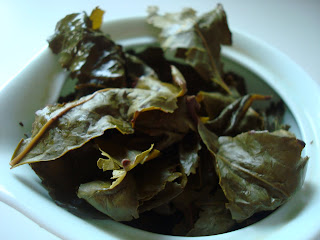The tin.
I decided to use my preschool-level Mandarin skills, a magnifying glass, and a couple of favorite websites (MDGB and NCIKU), to translate all of the Chinese text on the tin (even though I knew it would probably take me a few hours). During my time translating, I thought... "This is so cool. I'm going to learn so many fascinating new things about Tie Guanyin tea!"
Here's what I came up with. (Any of my Chinese-literate followers are invited to correct my translations or offer more details in the comments.)
安溪縣位於福建省的東南部,晉江西溪上游, 北緯 24° 50'〜25° 26',東經 117° 36'〜118° 17',地外南廈(門)漳(州)泉(州)金三角合部,居山而近海,隸屬歷名城泉州市。它東接南安縣,西連華安縣,北鄰永春縣,西南與長縣接壤,西北與漳平 縣交界。東西長 74公里,南北寬 63公里,面積 3057.28平方公里。縣境呈圓形,佮稱“一塊碟”,是泉州市地域最大的縣。
I gather that this is all just highly technical information about the geographical location of Anxi County.
介於綠茶和紅茶之間屬於半發酵茶類.
Semi-fermented [oxidized] tea is between green tea and black tea. (Well duh.)
福建安西勞動人民在清雍正三年至十三年(1725年至1735年)創制發明了青茶,首先傳人閩北後傳人台灣省。
Workers from Fujian province's Anxi county first invented this process between 1725 and 1735 (during Emperor Qing Yongzheng's rule), and they taught it to the "north of Min river" folks who moved to Taiwan.
So that was all it said on the tin!? I felt a little bit like Ralphie in "A Christmas Story" when he finished decoding Little Orphan Annie's secret radio message... and all it said was... "Be sure to drink your Ovaltine."
Anyway... I suppose it's time I got down to business and actually reviewed the tea.
This "1725 Tie Guan Yin" is from the Fujian Horizon Tea Co. Ltd. I could not figure out when the tea was made.
The leaves were packed not only in the lovely and collectible tin pictured above, but also in small single-serving vacuum sealed bags (which is fairly common). What I did not expect to find was another layer of plastic bag inside the first. Now that's a lot of packaging! I wonder if the tea inside will live up to all its packaging... or if this is all just a plot to sell mediocre tea to tourists. I was starting to worry as I opened up the second layer of plastic.
Here's what I found.
I was a little bit disappointed because I was hoping to find a roasted tea and it turned out to be a lightly oxidized TGY. Oh well. I poured the leaves into a large gaiwan and gave the tea a 3 second rinse with boiling water. It had a nice "minty-cheesecake" aroma.
My first two infusions were deemed "not offensive." Perhaps I had brewed them too weak because the broth was pretty dull.
The tea came alive for infusions three, four and five. It yielded a great yellow color with a few little sparkles on the surface. These infusions had peppery pine and mineral notes balanced by a touch of tropical flower aroma. They also had decent body. The sixth and seventh infusions fell flat and at times presented a little bit of bitter tobacco taste.
The third.
I like Tie Guanyin oolong tea quite a bit; in fact, one of my first experiences with premium Chinese tea was an unforgettable baked TGY that my mentor Donna Fellman shared with me almost nine years ago. That being said, I have always been a little wary of TGY oolong because I seem to have had just as many lackluster experiences as good ones.







3 comments:
It seems this tea at least used traditional processing, which is rather rare nowadays and I hope to see more traditional products!
I doubt the 1725 is specifically affiliated with the product's name, since I've seen it on many product packages, probably just as decoration.
Yeah, the colour of the tea is not green, but yellow.
BTW, it's not ren 人 but 入, so actually it should read "they invented the process of making qing tea, which first transmitted to Northern Fujian and then into Taiwan." No folks involved
Gingko - Thanks so much for the comment. I believe you're correct about the 1725 being more decoration than name.
MarshalN - Thanks so much for the correction! I clearly see what you're talking about. I just learned something!
Post a Comment